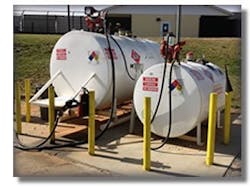How Healthy is Your Fuel Storage Tank?
Now is a good time to check your fuel storage procedures
Here's the problem: Today's fleets with high-pressure common rail diesel engines operate at 30,000 PSI with clearances measured in microns. That leaves almost no tolerance for contaminants, whether they be dirt particles, metal bits, or water. And because construction is inherently a dirty and damp business, everything you can do to eliminate water and debris before the fuel hits the filters on your heavy equipment helps.
Zero water is the only acceptable water level
Forget the old "a half inch or so of water in the tank is ok" school of thought. Water in diesel fuel spells disaster. And, if you are using a biodiesel blend, you are vulnerable on two fronts - the petroleum-based diesel in the blend and the biodiesel in the mix. Here's why-
Additives fuel manufacturers put into USLD to make up for the loss of lubricity that comes with eliminating sulfur have an affinity for water. “Additives cause water to exist in much smaller droplets and allows those droplets to stabilize in the fuel," says Christine Stanfel, chief engineer of global media development at Racor. Tier 4 engines are so sensitive to water that some injector manufacturers limit fuel to a maximum dissolved water content of 200 ppm, with a zero tolerance for free water.
Biodiesel is a haven for microbes. Biodiesel is less stable than regular diesel fuel because it is made of chemically converted fats and oils. Water and air combined with the biodiesel in your fuel blend, even if the bio percentage is low, creates a perfect world for bacteria and fungi to feed and produce a biogrowth slime that can double its size every 20 minutes. Microbes in that slime release acidic waste that clings to metal surfaces in storage tanks and engines. As the acid corrodes the metal, solid particles are released as contaminants and are easily transferred into your fleets fuel system.
When the fuel enters the Tier 4 vehicle, improved filtering technology helps catch the contaminates that are a byproduct of the water, as well as the water droplets themselves. But here's the catch -as the fuel filter catches the particles, it also blocks and holds water droplets. Those droplets cause the filter media swell as it holds the water. Glycerin in the fuel is attracted to the water in the filter and will build up, eventually clogging the filter and significantly reducing the filter's efficiency. If the compromised filter is used too long, more biogrowth develops within it. A true 'slippery slope'.
Keeping water out of your fleet's fuel can be a challenge, especially in summer's hot and humid weather. Here are some things to check to ensure your fuel storage and maintenance procedures are as pristine as possible.
- Does your fuel stink? Check your filters for a rotten egg odor. Those are sulphate reducing bacteria producing a sludgy byproduct that contains hydrogen sulfide.
- Storage tanks should be checked with a stick treated with water-finding paste before to every delivery. Tanks can settle to one side and unless you are checking at the low end, you can get a misleading indication of how much water is present. Most tanks have more water than can be easily detected so err on the side of caution.
- All water should be drained from storage tanks periodically. How often you do this depends on the ease of removal, the volume of fuel that has gone through the tank, and degree of water contamination situations.
- When draining water, be sure to keep pulling until the liquid is "clear and bright". Any remaining murkiness from an incomplete water pull probably contains 'active' bacteria that will be happy to go back to work contaminating your fuel and eating the tank's walls.
- The catch rim around the tank's fill cover opening collects solid and fluid debris that develop into biomass contamination and internal rust. It might not look like much but there are at least 27 varieties of bacteria that cause the majority of problems in diesel engines, according to the Gough Fluid Analysis Center. One microbe converts to 262,144 in 6 hours.
- Check the tank's vents, caps, seals, gaskets and hatches. Heat, ice, sunlight and time can compromise closures and connections and allow water to drip into the tank.
- Test your fuel's pH regularly. Diesel fuel is naturally acidic but a test that shows fuel with a pH of 5.5 may indicate microbial and fungal presence, which means water. If the tank is infected, biocides may be required to control microorganism growth.
Keep in mind that diesel and biodiesel fuels are more prone to water attraction as the temperature swings. The higher the temperature, the more water the fuel can hold. In a below or partially below ground storage tank, the fuel tends to stay cooler and allows the water and contaminates to settle at the bottom. Tanks that are exposed to temperature fluctuations due to climate and physical location do not always have enough time between temperature swings to settle out water completely.


